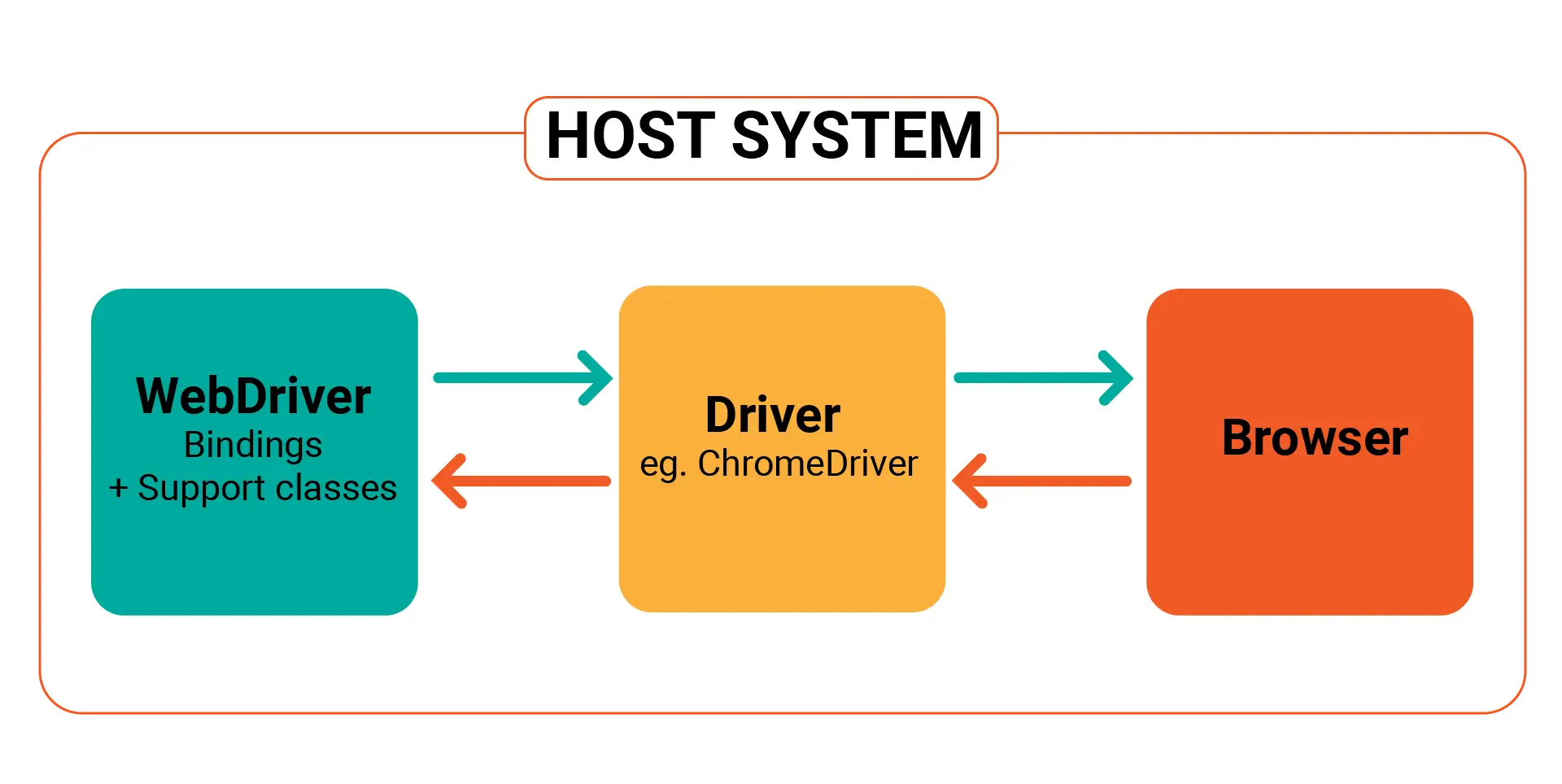Exploring Selenium/Appium Frameworks for Seamless Integration with HeadSpin
 Sam Atinkson
Sam Atinkson
HeadSpin offers robust testing and monitoring solutions tailored for mobile applications. When you integrate HeadSpin with your Selenium framework, you unlock the potential to broaden your testing scope to encompass mobile devices, thus guaranteeing a consistent user experience across diverse platforms. This guide delves into the various Selenium/Appium frameworks that can augment your testing endeavors in conjunction with HeadSpin
Selenium WebDriver
Selenium WebDriver, often referred to simply as WebDriver, serves as a cornerstone in automated testing, programmatically enabling interaction with web browsers. It represents the evolution of Selenium, replacing Selenium Remote Control, and encompasses an array of components working harmoniously to facilitate test execution.
API: Selenium WebDriver boasts language-specific bindings, such as Selenium Java, Selenium Ruby, Selenium dotnet, etc., which bridge the gap between scripts written in various scripting languages and Selenium's built-in language, Selenese. These bindings and the API are housed within the Selenium Library.
Driver: The WebDriver comprises executable modules responsible for launching browser instances and executing test scripts. These drivers can be browser-specific, like Chromedriver for Google Chrome, ensuring compatibility and seamless execution across different browsers.
- Browser Support: Selenium WebDriver extends support to a range of modern browsers, including Chrome, Firefox, Opera, Safari, and Internet Explorer, facilitating comprehensive testing across diverse browser environments.

Appium Driver
Appium Driver is a versatile tool specifically tailored for mobile application testing, offering seamless interaction with mobile devices across different platforms. It shares similar architecture and functionality with Selenium WebDriver but is optimized for mobile testing scenarios.
API: Appium offers language-specific interfaces like Appium Java, Appium Python, Appium Ruby, and more. This allows developers to create test scripts using their favorite programming languages. These findings, coupled with the Appium API, streamline mobile test automation.
Driver: Appium Driver encompasses executable modules responsible for launching and interacting with mobile application instances on devices or emulators/simulators. These drivers are platform-specific, ensuring compatibility and efficient execution across various mobile platforms, including iOS and Android.
Device Support: Appium Driver offers extensive device support, enabling testing on a wide range of devices, including smartphones, tablets, and wearable devices. It ensures comprehensive coverage across different device configurations and platforms, enhancing the quality and reliability of mobile applications.

There are several types of Selenium/Appium frameworks designed to streamline the process of test automation and enhance test maintenance and scalability. Here are some common types of Selenium/Appium frameworks:
1. Keyword-Driven Framework
The keyword-driven framework allows testers to create test cases using keywords that abstract the actions performed by the test scripts. Keywords are associated with specific test actions, enhancing the readability and maintainability of test cases.
Advantages:
Readable and easily understandable test cases.
Separation of test logic from test data, improving maintainability.
Reusability of keywords across multiple test cases.
Disadvantages:
Initial setup and configuration may be time-consuming.
Requires additional effort to define and manage keywords.
Example:
Keyword("Login")
Keyword("NavigateToHomePage")
Keyword("SearchForProduct")
Keyword("AddToCart")
2. Data-Driven Framework
In the data-driven framework, test scripts are separated from test data, enabling the execution of the same test script with different sets of data. Test data can be stored in external files like Excel sheets or databases, allowing for easy scalability and maintenance.
Advantages:
Allows testing with multiple sets of data, improving test coverage.
With easy scalability, new test data can be added without modifying test scripts.
Enhances reusability and maintainability of test scripts.
Disadvantages:
Managing large volumes of test data can become complex.
Dependency on external data sources may introduce additional points of failure.
Example:
Test with Username: user1, Password: pass1
Test with Username: user2, Password: pass2
3. Page Object Model (POM)
POM is a design pattern that represents web pages and their elements in an object-oriented manner. Each web page is treated as a class, with its elements encapsulated as methods, promoting code reusability and reducing duplication.
Advantages:
Encapsulates page elements and interactions, promoting code reusability.
Enhances test maintenance and readability by separating page structure from test logic.
Facilitates easy updates to test scripts when UI changes occur.
Disadvantages:
Initial setup and implementation may require more time.
Requires understanding of object-oriented programming concepts.
Example:
LoginPage.loginWithCredentials("username", "password");
HomePage.searchForProduct("product");
4. Hybrid Framework
A hybrid framework combines different frameworks like Keyword-Driven, Data-Driven, and POM to leverage the benefits of each approach, offering flexibility and scalability for testers.
Advantages:
Combines the benefits of multiple frameworks for flexibility and scalability.
Allows testers to choose the most suitable approach for each test scenario.
Disadvantages:
Complexity may increase due to the integration of multiple frameworks.
Requires careful planning and design for seamless integration.
Example:
Keyword("Login")
Data-Driven("SearchForProduct")
POM("AddToCart")
5. Behavior-Driven Development (BDD) Framework
BDD frameworks like Cucumber and JBehave facilitate collaboration between stakeholders by enabling tests to be written in plain language using Gherkin syntax, promoting clear communication and alignment between business requirements and test cases.
Advantages:
Promotes collaboration through plain language test cases.
Improves clarity and alignment between business requirements and test cases.
Disadvantages:
Requires additional tooling and setup for BDD implementation.
May introduce overhead in writing and maintaining feature files.
Example:
Feature: Search functionality
Scenario: User searches for a product
Given the user is on the homepage
When the user searches for "product"
Then, search results should be displayed
**6. Modular Framework
**
In the modular framework, test scripts are divided into smaller, reusable modules based on functionality or features. These modules can be combined to create test cases, improving code maintainability and scalability.
Advantages:
Promotes code reusability and maintainability through smaller modules.
Allows easy scalability and updates to individual modules.
Disadvantages:
Requires careful planning and design to define module boundaries.
Over-modularization may lead to increased complexity.
Example:
Module("Login")
Module("Search")
Module("Checkout")
**7. TestNG Framework
**
TestNG is a testing framework seamlessly integrated with Selenium WebDriver, offering features like parallel execution, data-driven testing, and test grouping. It provides annotations to define test methods and supports assertions for test validation.
Advantages
Seamless integration with Selenium WebDriver/Appium Driver for parallel execution and data-driven testing.
Annotations simplify test method definition and execution.
Supports assertions for test validation.
Disadvantages
The learning curve for understanding TestNG annotations and features.
Requires additional setup for integrating with Selenium WebDriver/Appium Driver.
Example:
@Test
public void testSearchFunctionality() {
// Test logic goes here
}
Conclusion
The integration of Selenium and Appium frameworks with HeadSpin opens up a world of possibilities for comprehensive mobile application testing. Whether you choose Selenium WebDriver for web browsers or Appium Driver for mobile devices, understanding the various frameworks discussed here – Keyword-Driven, Data-Driven, POM, Hybrid, BDD, Modular, and TestNG – empowers you to optimize your testing efforts. Each framework has its advantages and considerations, allowing you to tailor your approach based on the specific needs of your testing scenarios. By embracing these frameworks, testers can ensure a consistent user experience, streamline test maintenance, and achieve scalability in their mobile application testing endeavors.
Originally Published:- https://www.headspin.io/blog/selenium-appium-frameworks-for-headspin-integration
Subscribe to my newsletter
Read articles from Sam Atinkson directly inside your inbox. Subscribe to the newsletter, and don't miss out.
Written by

Sam Atinkson
Sam Atinkson
Sam Atkinson is a results-driven SEO Executive with 3 Years of experience in optimizing digital visibility and driving organic growth. Skilled in developing and executing strategic SEO initiatives, Sam excels in keyword research, technical audits, and competitor analysis to elevate online presence and improve search engine rankings. With a keen eye for detail and a passion for delivering measurable results, Sam collaborates cross-functionally to align SEO efforts with business objectives and enhance website performance. Committed to staying ahead of industry trends.